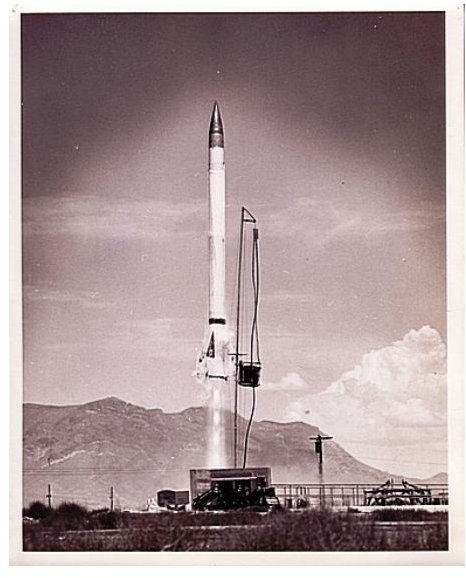Rocket History Development--Sounding Rockets to the Edge of Space
Viking
As the Aerobees were testing the upper reaches of the atmosphere, the Navy Research Laboratory (NRL) developed a large sounding rocket designed to compete with and replace the rapidly dwindling supply of V2s. The new rocket was slim and much lighter than the war time V2. Standing just over 48 feet high, the Navy’s rocket was only 32 inches in diameter.
This slim elegant rocket was named Viking. It featured several advances in rocket design. First, the fuselage body was used as the outer wall of the propellant tanks. This was known as integral tankage and saved a great deal of weight. Viking also featured the first gimbaled motor. The V2 used graphite vanes in the exhaust for steering. Gimbaling the motor made steering much more precise. All rockets today use gimbaled motors.
Its motor produced a thrust of 21,000 pounds, allowing it to loft a payload of 500 pounds.
Only seven of these slim Vikings were flown. Viking 7 reached an altitude of 136 miles, breaking the V2’s 114 mile record.
A New Viking
The Navy saw that the original Viking did not carry sufficient propellant for greater altitudes, so the NRL set about redesigning the rocket. Using the same engine and basic design, the new Viking was only about 41 feet high, but 45 inches in diameter.
This Viking added another advance to rocket history development. Small rockets to control the vehicle’s attitude outside the atmosphere were added. Such control systems are now a part of every space launch vehicle and spacecraft.
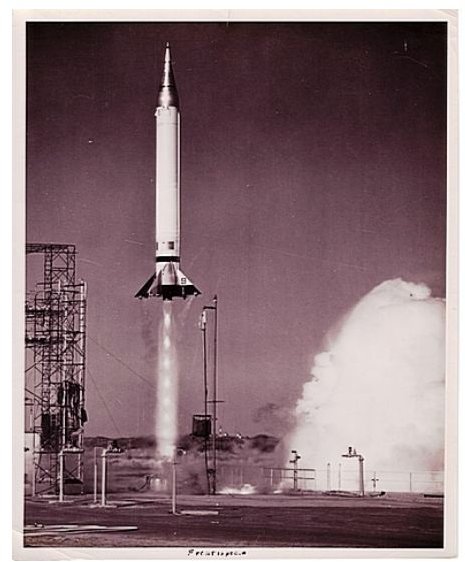
The additional propellant also enabled the new model to loft a heavier payload—1000 pounds. Only five of these big Vikings were flown, but Viking 11 reached an altitude of 158 miles, the record for a single stage rocket.
While Viking’s career was short, it would be resurrected at the dawn of the space age. It would become the booster for what was supposed to be our first satellite.
The New Sounding Rockets
By the end of Viking’s career, a new breed of sounding rockets were coming on the scene. Taking a cue from Aerojet General’s use of surplus Nike boosters with the Aerobee 350, many firms and research organizations began using the Nike booster with other solid propelled rockets.
One of the most popular was the Nike-Tomahawk. The Tomahawk was a single stage sounding rocket developed by Sandia Corporation with a Thiokol solid propellant motor. It was never particularly successful, but when paired with the powerful Nike booster, the combination became a very successful research tool. Altitudes as high as 1167 miles have been reached by this pairing.
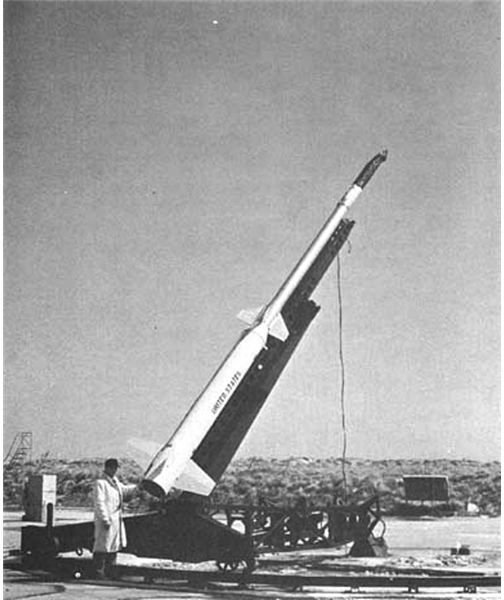
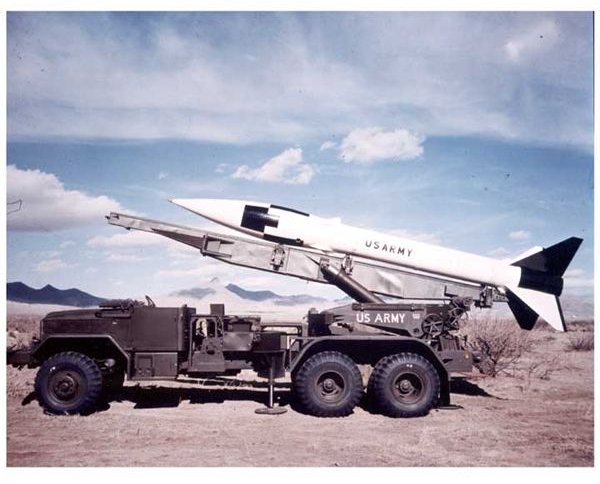
Another pairing with the Tomahawk is with the Honest John booster. The Honest John was one of the Army’s first artillery rockets. It was distinctive because of its bulbous upper fuselage. This was the warhead. The Honest John booster was more powerful than the Nike, and had a longer burn time. When mated with an upper stage, such as the Tomahawk, the pair were usually designated the Taurus-xxx.

Nikes, Honest Johns, and other former Army boosters came into use, as did many other vehicles as upper stages and single stage research rockets.
The Curse of the IGY
In 1952, the International Council of Scientific Unions (ICSU) proposed a global geophysical research effort to cover the world from pole to pole, ocean to ocean and continent to continent. It would be the International Geophysical Year (IGY), to occur from July 1957 to December 1958. But perhaps the most publicly exciting proposals came from the U.S. and the Soviet Union.
Both proposed to launch the world’s first Earth satellites.
U.S. intelligence, blinded by the Iron Curtain, did not believe the Soviets had the technology to reach orbit, so the U.S. looked for a launch vehicle for its satellite. The Redstone Arsenal’s Von Braun team proposed a vehicle based on its Redstone booster—the Jupiter-C. But it was still too soon after WWII to let someone who had worked for Hitler be involved with a civilian project. Chosen instead was a vehicle based on the Viking, with an uprated Aerobee second stage and solid third. This was the Vanguard. It was to launch the U.S.’s first satellite, a grapefruit sized ball that had a few instruments.
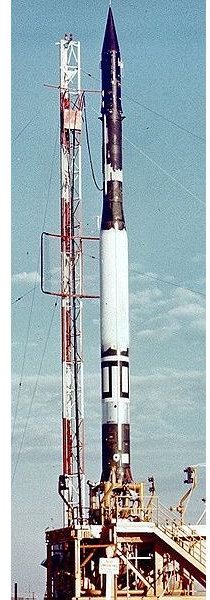
Now earlier that decade the Air Force had submitted a proposal to the Pentagon for a shot at the moon. The proposal used a Thor IRBM as a booster, an Aerobee second stage, and a solid third stage.
The Secretary of Defense at the time was the former General Motors CEO, Charley Wilson. Wilson was a self-centered, rough talking, closed minded individual. He tossed the proposal in the waste basket, saying, “We’re not messing with that Buck Rogers (expletive deleted).”
Unfortunately, the Soviets were messing with it.
.
The IGY Shock
On Oct. 4, 1957, the Soviets launched the world’s first satellite from the Tyuratam launch site. The satellite weighed 184 pounds, far more than Vanguard’s 3.5 pound grapefruit. A month later, the Soviets shocked the world again with a much heavier satellite—carrying the dog Laika.
The U.S. had yet to launch its Vanguard.
The shock of the Soviet feats forced the Vanguard project into high gear. Project engineers, under pressure from Washington, rushed the first vehicle to the launch pad at Cape Canaveral. On Dec. 6. 1957, The uprated Viking booster ignited, and lifted off the pad. It rose about two feet. The motor burned through, exploded, and the hope of America crumpled back on the pad in flames. The grapefruit deployed from the nosecone, rolled onto the beach, and began transmitting.
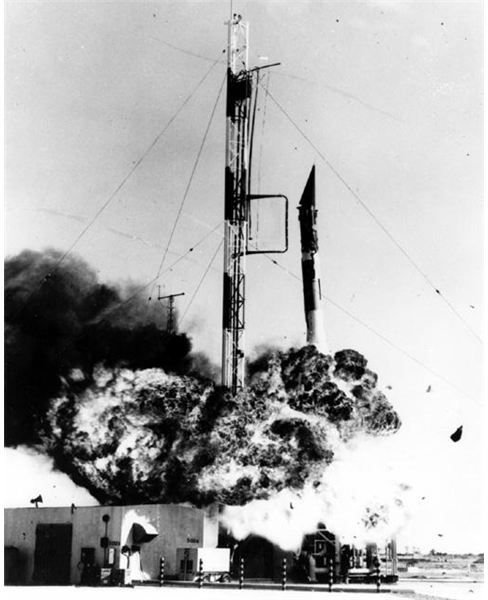
To say there was consternation in Washington is a severe understatement. It was no longer politically incorrect for a former German to build a vehicle to launch the U.S. satellite.
Von Braun promised he could have the vehicle and satellite ready in three months. He bettered his prediction. On Jan.31, 1958, a Jupiter-C launched the Explorer 1, America’s first satellite. It weighed only 31 pounds and was 80 inches long (and half of that was the 4th stage motor). But America was in space!
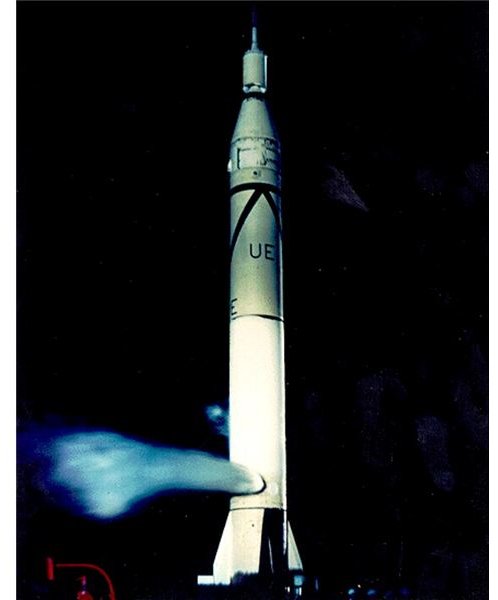
Several Explorers were launched. The name is used even to this day for various series of satellites and probes, but the Jupiter-C has long since been retired.
How the Soviets Beat the U.S. into Space
The Soviet’s big leap ahead in space was not due just to Charley Wilson’s intransigence and diminutive thinking on the part of officials and researchers. The U.S. was developing IRBMs (Intermediate Range Ballistic Missile) with a range of 1500 nautical miles and ICBMs (Intercontinental Ballistic Missile) with ranges of 6000 nautical miles (a nautical mile is 6000 linear feet as opposed to the 5280 feet of a statute mile).
As soon as the captured V2s and the German scientists reached the Soviet Union, the Kremlin set to work to turn a revered Russian scientist’s dream into reality. Konstantin Tsiolkovsky in 1903 had proposed using rockets to reach and fly in space. He even developed the concept of multistage rockets before Oberth.
The Soviets flew their V2s, but immediately built their own, larger version, the G1. This had a range of 600 miles, and used an uprated version of the basic V2 motor.

A series of other designs followed quickly, culminating in an IRBM, the R5. This was the ultimate exploitation of the V2 technology. After the R5, the Soviets introduced their own rocket technology.

The breakthrough was the RD-107 engine, a cluster of four motors developing a total of 213,000 pounds of thrust. The Soviet
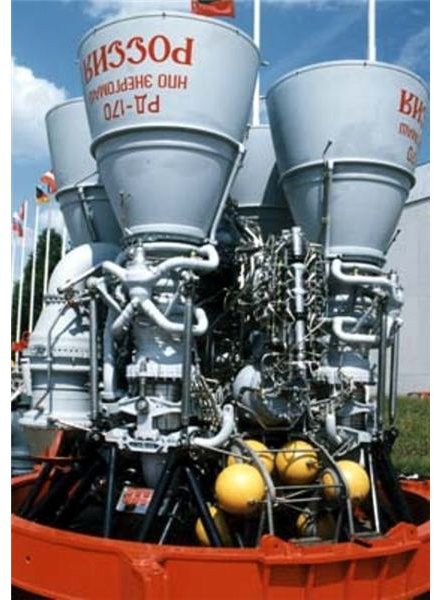
brilliance was to cluster these engines to create a booster with a total of almost one million pounds of thrust. The R-7 booster clustered four strap-ons using RD-107s around a central RD-107 powered core with slightly more power.
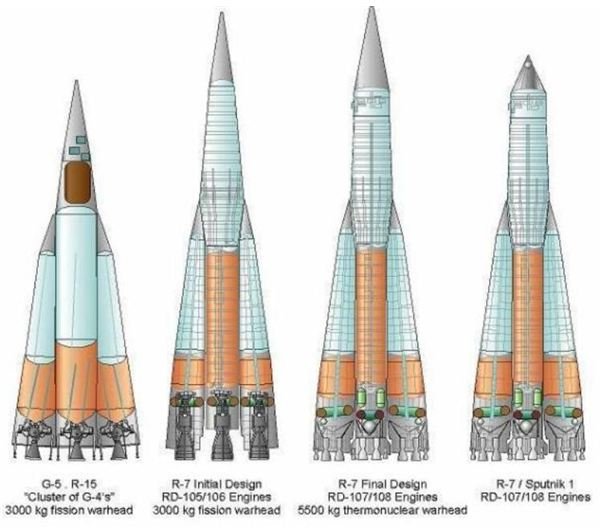
This became their ICBM. It also launched Sputnik and several more of their early satellites.
On April 12, 1961, an R-7 with an upper stage put Yuri Gagarin into orbit to become the first human in space. Once again the U.S. had been beaten into space.

But in a short time, rocket history development would change dramatically, as we will see in part 3.
Sources and Credits
Sources:
https://www.russianspaceweb.com/sputnik_lv.html
Elway, Peter, Rockets of the World, 1993
Credits:
RD-107 engine: https://www.aerospaceguide.net/rocketengines/russianengines.html
Vanguard/Jupiter-C, Russian rocket images: NASA https://spaceflight.nasa.gov/gallery/images/
Soviet vehicle illustrations: https://www.astronautix.com/articles/conssite.htm © Mark Wade (used with permission)
All other photos: personal collection
This post is part of the series: All About Rockets
The design of modern rockets went through many variations in their brief history since 1926. Sounding rockets provided the basis for the technology that would eventually take us into space.
